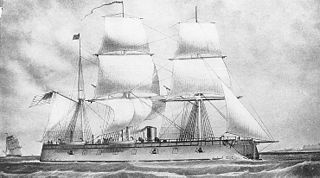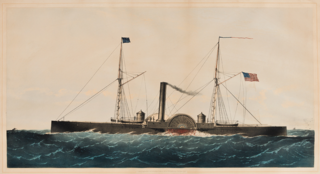
USS Galena was a wooden-hulled broadside ironclad built for the United States Navy during the American Civil War. The ship was initially assigned to the North Atlantic Blockading Squadron and supported Union forces during the Peninsula Campaign in 1862. She was damaged during the Battle of Drewry's Bluff because her armor was too thin to prevent Confederate shots from penetrating. Widely regarded as a failure, Galena was reconstructed without most of her armor in 1863 and transferred to the West Gulf Blockading Squadron in 1864. The ship participated in the Battle of Mobile Bay and the subsequent Siege of Fort Morgan in August. She was briefly transferred to the East Gulf Blockading Squadron in September before she was sent to Philadelphia, Pennsylvania for repairs in November.

USS Canonicus was a single-turret monitor built for the United States Navy during the American Civil War, the lead ship of her class. The ship spent most of her first year in service stationed up the James River, where she could support operations against Richmond and defend against a sortie by the Confederate ironclads of the James River Squadron. She engaged Confederate artillery batteries during the year and later participated in both attacks on Fort Fisher, defending the approaches to Wilmington, North Carolina, from December 1864 to January 1865.

USS New Ironsides was a wooden-hulled broadside ironclad built for the United States Navy during the American Civil War. The ship spent most of her career blockading the Confederate ports of Charleston, South Carolina, and Wilmington, North Carolina, in 1863–65. New Ironsides bombarded the fortifications defending Charleston in 1863 during the First and Second Battles of Charleston Harbor. At the end of 1864 and the beginning of 1865 she bombarded the defenses of Wilmington in the First and Second Battles of Fort Fisher.

USS Fort Jackson was a wooden sidewheel steamer in the United States Navy during the American Civil War. She was successful in enforcing the Union blockade of Confederate ports, capturing five ships carrying contraband. She participated in the battles for Fort Fisher, which effectively closed the port of Wilmington, North Carolina to the Confederacy. Most notably, the surrender of Confederate forces in Texas was signed aboard the ship, formally ending the Civil War in that portion of the country.

USS Varuna was a screw steamer acquired by the Union Navy during the American Civil War. Under construction in 1861, she was purchased incomplete on 31 December. After being commissioned in February 1862, she traveled to join the West Gulf Blockading Squadron. Varuna was present when Flag Officer David Glasgow Farragut led an attack against Confederate positions at Fort Jackson and Fort St. Philip on 24 April. During the action, Varuna ran ahead of the other Union ships, and was engaged in a chase with the Louisiana gunboat Governor Moore. After closing in on the Union ship, Governor Moore rammed Varuna twice, with the gunboat CSS Stonewall Jackson adding a third blow. Varuna sank within 15 minutes, but Farragut was able to capture the city of New Orleans, Louisiana.
USS John P. Jackson (1860) was a steamship acquired by the United States Navy during the beginning of the American Civil War. She was assigned to the Union blockade of the Confederate States of America. as well as the bombardment of Mississippi River ports.

Stephen Decatur Trenchard was a rear admiral in the United States Navy. He was present at the Battle of Taku Forts in 1859, and commanded the supply ship and gunboat Rhode Island throughout the American Civil War, seeing action at both Battles of Fort Fisher. He later commanded the North Atlantic Squadron.
USS Somerset was a wooden-hulled, side-wheel ferryboat built at Brooklyn, N.Y., in 1862, which was purchased by the Navy at Washington, D. C., on 4 March 1862 and was commissioned at the New York Navy Yard on 3 April 1862, Lt. Earl English in command.
The second USS Kensington was a steamship in the United States Navy.

USS Osceola was a wooden, sidewheel Sassacus-class gunboat which saw combat with the Union Navy in the American Civil War. She was designed with shallow draft and double-ends specifically to allow her to operate in the narrow rivers and inlets along the Confederate coast. She was well suited to this role and took part in major battles on the James and Cape Fear Rivers.

USS Wissahickon was a Unadilla-class gunboat that was built for service with the United States Navy during the American Civil War.
USS Yankee was a steam-powered side-wheel tugboat acquired by the Union Navy just prior to the outbreak of the American Civil War.

USS Commodore Morris was a ferryboat acquired by the Union Navy during the American Civil War. Ferryboats were of great value, since – because of their flat bottom and shallow draft – they could navigate streams and shallow waters that other ships could not.

USS Commodore McDonough was a ferryboat acquired by the Union Navy during the American Civil War. Ferryboats were of great value, since – because of their flat bottom and shallow draft — they could navigate streams and shallow waters that other ships could not.

USS Underwriter was a 341-ton sidewheel steamer that was purchased for military use by the Union Navy during the American Civil War.
USS Morse was a ferryboat acquired by the Union Navy during the American Civil War.

USS Pembina was a Unadilla-class gunboat built for the Union Navy during the American Civil War. She was used by the Navy to patrol navigable waterways of the Confederacy to prevent the South from trading with other countries.

USS Calhoun was a captured Confederate steamer and blockade runner acquired by the Union Navy from the prize court during the American Civil War.
USS Stepping Stones was a steamer purchased by the Union Navy during the early part of the American Civil War.
USS Shokokon was a large (709-ton) steamer with powerful 30-pounder rifled guns, purchased by the Union Navy during the beginning of the American Civil War.












